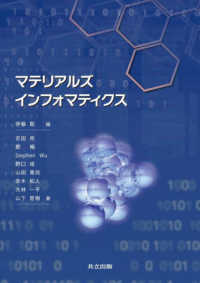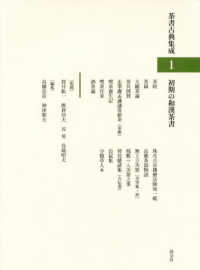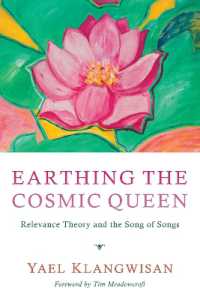- ホーム
- > 洋書
- > 英文書
- > Nature / Ecology
Full Description
This collection features five peer-reviewed reviews on optimising photosynthesis in crops.
The first chapter reviews current understanding of the biochemistry, regulation and limitation of the C3 photosynthesis cycle in crops. It provides detailed discussions on CO2 assimilation in C3 photosynthesis, as well as the carboxylation, reduction and regeneration phases of the C3 cycle.
The second chapter considers the recent emergence of using phenotyping techniques to analyse crop functionality and photosynthesis. It reviews the relationship between photosynthesis, crop growth and stress response and explores phenotyping photosynthesis in varying environments.
The third chapter discusses the process of modifying mesophyll conductance to optimise photosynthesis in crops. The chapter considers recent research efforts to manipulate the structure and composition of cells walls, membranes and liquid phases to achieve this.
The fourth chapter explores improving photosynthesis in rice and details the need to optimise photosynthetic efficiency as a means of boosting yield ceilings in rice production.
The final chapter reviews some of the key factors determining photosynthetic performance and explores the options for improving the photosynthetic capacity and efficiency of wheat by selecting for a range of important traits.
Contents
Chapter 1 - Understanding the biochemistry of C₃ photosynthesis in crop plants: C. A. Raines, A. P. Cavanagh, C. Afamefule, K. Chibani, H. Gherli, P. Lopez, V. Mengin, B. Moreno-García and S. Wall, The University of Essex, UK; 1 Introduction 2 The carboxylation phase 3 The reduction phase
4 The regeneration phase 5 Regulation of the C3 cycle enzymes 6 Approaches to determine which enzymes limit the flow of carbon through the C3 cycle 7 Future opportunities to improve the C3 cycle 8 Where to look for further information 9 References
Chapter 2 - Using phenotyping techniques to analyse crop functionality and photosynthesis: Eva Rosenqvist, University of Copenhagen, Denmark; 1 Introduction 2 Understanding photosynthesis and its relationship to crop growth and stress response 3 Phenotyping photosynthesis in varying environmental conditions
4 Using gas exchange to analyse photosynthesis 5 Using porometry and thermal imaging of gs and hyperspectral techniques 6 Using chlorophyll fluorescence 7 Photosynthesis and climate change: accounting for heat stress, drought stress and elevated CO2 8 Case studies 9 Conclusions 10 Where to look for further information 11 References
Chapter 3 - Modifying mesophyll conductance to optimise photosynthesis in crops: Coralie E. Salesse-Smith, University of Illinois at Urbana-Champaign, USA; Steven M. Driever, Wageningen University and Research, The Netherlands; and Victoria C. Clarke, The Australian National University, Australia; 1 Introduction 2 Points of resistance to diffusion of CO2 3 The interaction between mesophyll cell anatomy, light and gm 4 Leaf age and gm 5 Cell wall diffusion 6 Cellular membranes and CO2 diffusion 7 Improving gm using aquaporins as CO2 channels 8 CO2 solubility in liquids
Chapter 4 - Improving photosynthesis in rice: from small steps to giant leaps: R. F. Sage, University of Toronto, Canada; and Shunsuke Adachi and Tadashi Hirasawa, Tokyo University of Agriculture and Technology, Japan; 1 Introduction 2 Demand functions in C 3 plants: biochemical limitations 3 Supply functions in C 3 plants: diffusion limitations 4 Strategies for improving photosynthetic performance 5 Future trends and conclusion 6 Where to look for further information 7 References
Chapter 5 - Photosynthetic improvement of wheat plants: Martin A. J. Parry, João Paulo Pennacchi, Luis Robledo-Arratia and Elizabete Carmo- Silva, Lancaster University, UK; and Luis Robledo-Arratia , University of Cambridge, UK; 1 Introduction 2 Light capture: canopy duration and architecture 3 Spike photosynthesis 4 CO 2 concentration 5 Calvin-Benson and photorespiratory cycles and beyond 6 Conclusion 7 Where to look for further information 8 References








